What Are Unmanned Hyperscale Data Centers? Benefits, Examples, and Trends
Unmanned Hyperscale Data Centers, commonly known as “lights out”, are one of the most fascinating use cases for hyperscale facilities. Its operation has been made possible by the IoT and artificial intelligence (AI), supported by the strength of hyperscale computing.
Operators are under increased pressure to become leaner, greener, and faster to meet the demands of hyperscale computing.
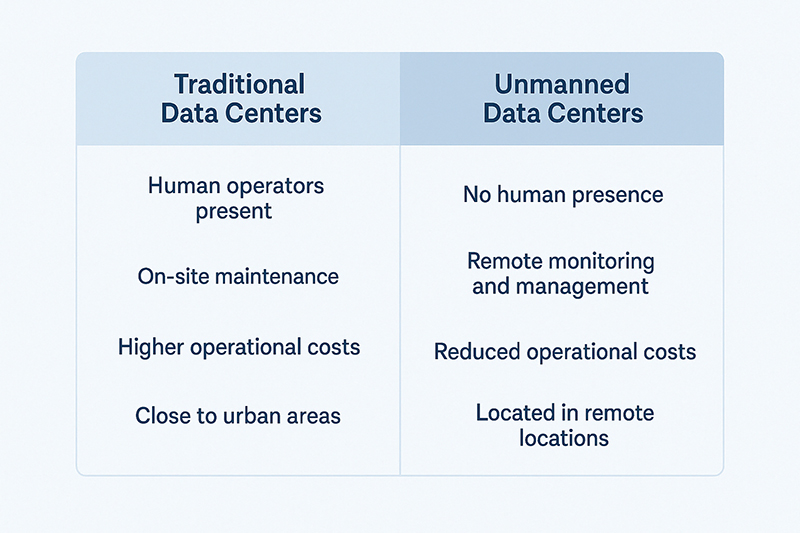
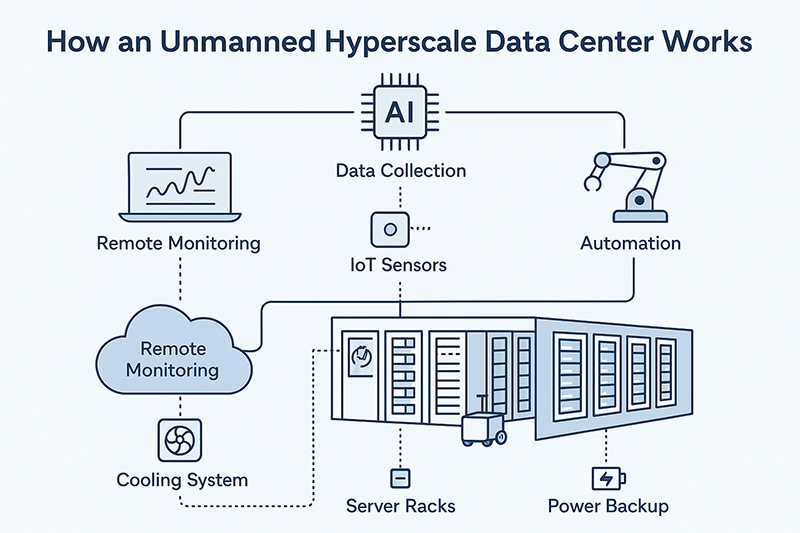
Examples of Unmanned Hyperscale Data Centers
Microsoft’s Project Natick:
Overview: Microsoft launched Project Natick to explore the possibility of underwater, unmanned data centers as a way to improve energy efficiency and reduce environmental impact. The project involved creating a self-sustaining, submerged data center that is cooled naturally by the surrounding ocean water. This eliminates the need for traditional air-conditioning systems.
Relevance to Unmanned Hyperscale Data Centers: While not fully unmanned in terms of operation, the concept demonstrates how automation, combined with natural cooling, can significantly reduce operational costs and environmental impact. The idea behind Project Natick aligns closely with unmanned hyperscale data centers that rely on automation and advanced monitoring systems. These reduce the need for human intervention.
Novva Data Centers:
Overview: Novva is focused on building large-scale, unmanned data centers using a combination of renewable energy and highly automated processes. They aim to run data centers without on-site staff, relying instead on AI and robotics for maintenance and monitoring.
Relevance to Unmanned Hyperscale Data Centers: Novva’s facilities are designed with sustainability in mind. Using green energy sources and ensuring that the data centers can operate with minimal human presence, leading to reduced carbon footprints and operational costs. Their use of automated systems reduces the human error factor and allows for 24/7, lights-out operations.
Google’s Data Center Automation:
Overview: Google has long been a pioneer in the use of automation within its data centers. The company uses machine learning algorithms to monitor and adjust systems to optimize cooling and power usage, thereby reducing waste.
Relevance to Unmanned Hyperscale Data Centers: Google’s highly automated data centers are effectively unmanned, operating with minimal human interaction. They have also pioneered the use of AI to predict potential failures and automatically perform repairs or adjustments. This creates an environment where human intervention is reduced to an absolute minimum.
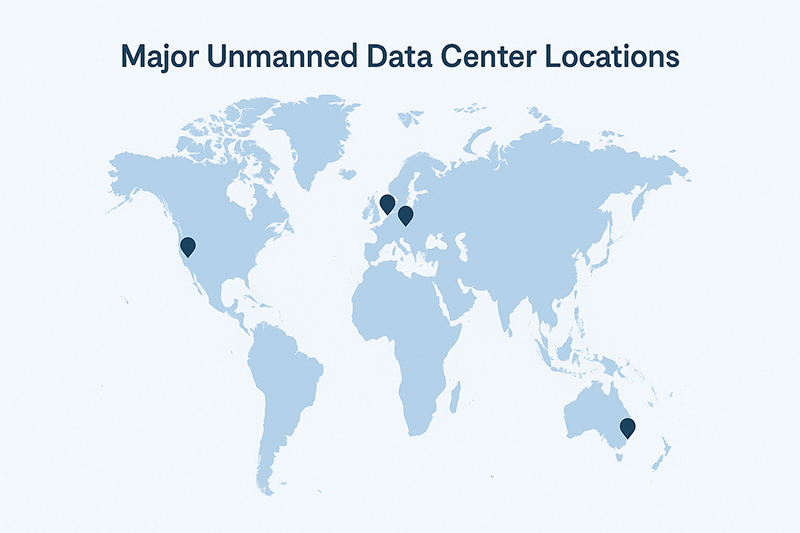
Monitoring At The Edge
Can unmanned operations also be implemented at the edge?
Due to the growth in Edge deployments and limitations on size and power usage in hard-to-reach places, edge data centers are unintentionally the pioneers of ‘lights-out’ operations.
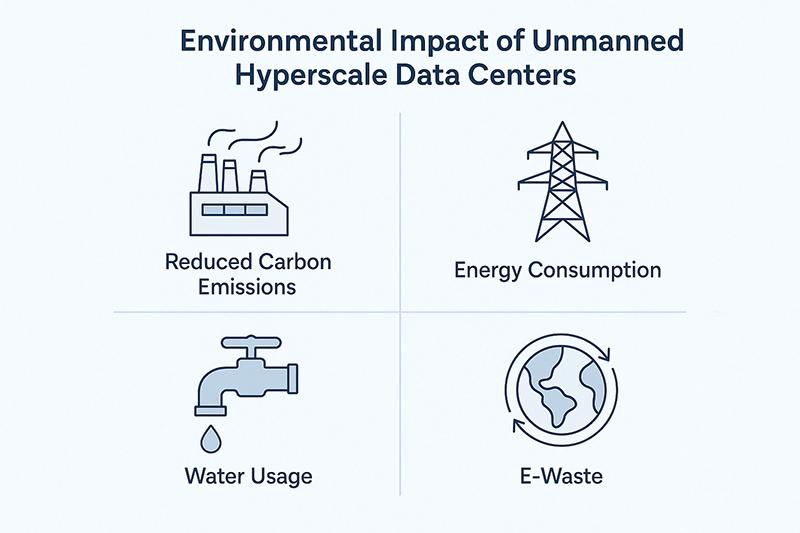
Environmental Impact of Unmanned Hyperscale Data Centers
Energy Efficiency and Reduced Cooling Needs:
Unmanned hyperscale data centers leverage automation to optimize energy usage, particularly with respect to cooling. Traditional data centers consume a lot of power for air conditioning and cooling systems. However, unmanned centers utilize advanced cooling technologies, such as liquid cooling or using the ambient environment (e.g., underwater or air-based cooling) to significantly reduce energy consumption.
Example: Microsoft’s Project Natick uses the natural cooling of the ocean to reduce the energy needed for air conditioning, potentially cutting energy consumption by up to 30%. This reduction in energy usage helps decrease the overall carbon footprint of the data center.
Renewable Energy Integration:
Many unmanned data centers are designed with sustainability in mind, incorporating renewable energy sources such as solar, wind, and hydroelectric power. This reduces the reliance on fossil fuels and lowers greenhouse gas emissions. Even miniaturized nuclear reactors are being considered.
Example: Novva Data Centers is committed to using renewable energy sources to power its facilities, minimizing environmental damage and ensuring that the data centers run sustainably without relying on non-renewable energy.
Reduction of Human Transportation and On-Site Energy Consumption:
By automating operations, unmanned data centers reduce the need for on-site staff and the associated transportation energy consumption. Fewer workers on-site means fewer vehicles on the road, contributing to a reduction in overall carbon emissions from transportation.
Example: AI-powered robots can perform routine maintenance and inspections, eliminating the need for human technicians to commute to the facility.
Minimal Resource Waste:
Unmanned data centers use advanced AI and IoT technologies to predict and optimize system performance, ensuring that equipment is used efficiently and preventing unnecessary waste of resources.
Example: Google’s AI system, DeepMind, has been successfully applied to data center operations, where it continuously monitors and adjusts the cooling systems to reduce energy consumption. This process not only saves energy but also extends the life of equipment, reducing e-waste.
Long-Term Sustainability and the Circular Economy:
As unmanned data centers become more widespread, the use of modular, scalable designs allow for easier upgrades. This helps promote a circular economy, where components are reused or recycled rather than disposed of, reducing waste and promoting sustainability.
Example: The use of recyclable materials in the construction of data center modules, as seen with companies like EdgeCore, promotes a circular approach by allowing components to be upgraded or reused rather than discarded.
Unmanned Hyperscale Data Center Features
Critical performance metrics for data centers include air and equipment temperatures. In their pursuit of greater cooling effectiveness, hyperscalers frequently operate on the edge of safety.
Equipment failure can result from temperatures just one degree beyond the limit. Operating in a highly efficient cooling environment means there is little margin for error.
In an unmanned data center therefore real-time data and analytics are incorporated into continuously improved temperature profiles. Rather than warning human operators when conditions change. Pressure, vibration, temperature and humidity sensors are deployed for this purpose.
Fire Protection
Hyperscale data centers are particularly susceptible to fire threats due to their high energy density, static electricity, and abundance of combustible materials. Equipment, facilities, and employees are all designed to be protected by National Fire Protection Association (NFPA) regulations and codes.
Data centers have traditionally used smoke detectors, fire extinguishers, and sprinklers, just like many other sectors. Reactive approaches are no longer sufficient because of the financial costs associated with downtime or lost data. More localized approaches that include in cabinet fire suppression are being utilized that minimize the impact of downtime.
Remote Automation
Automation and remote data center monitoring have advanced simultaneously as the hyperscale ecosystem has grown. On the road to automated operation, the two routes have converged, and real-time data is now feeding the data center’s internal artificial intelligence.
AI skips notifications to execute autonomous solutions rather than continuously scanning for circumstances that require human action. Customers can see more clearly thanks to remote monitoring and automation, and the unlimited access to real-time and historical data yields more useful insights.
Power Monitoring
Operators and the environment both benefit from remote power monitoring. Lights-out hyperscale uses intelligent power distribution units (iPDUs), which are a popular choice.
To optimize power settings, per-outlet power sensing delivers real-time data at the individual device level. Component failures are foreseen and on-site technician time is reduced when hyperscale predictive intelligence is strengthened in remote power monitoring.
To reduce overall power usage, stranded capacity and other waste causes are quickly detected and fixed.
Security
For autonomous data centers, data security and physical security are crucial factors. By default, physical security increases with fewer facility visits. Practical physical access barriers include facial recognition software and other biometric authentication techniques.
IoT surveillance robots or drones can provide an additional layer of round-the-clock physical security. Threat intelligence techniques use enriched flow records and packet data to proactively detect signs of compromise in place of redundant infrastructure and encryption to protect data security (IOC). The unmanned data center operation is complemented with dashboards and real-time threat maps.
Unmanned Hyperscale Benefits
Data centers without employees used to appear like something out of science fiction.
In addition to the autonomy of operation being convenient, each contributing component increases effectiveness. This includes the elimination of geographical restrictions and the optimization of power, cooling, and security based on real-time adjustment.
Data centers can now be located everywhere, including underwater, in cooler but less friendly climes as human presence is no longer required.
The removal of people from the data center does not diminish their importance, as we have learned from earlier industrial revolutions. Professionals in IT and computer science will have more time to focus on proactive duties like advanced threat hunting, capacity planning, and algorithm improvement.
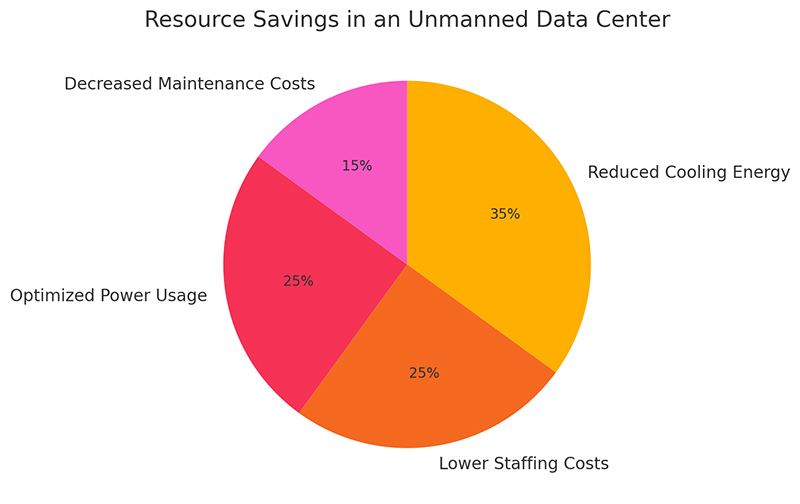
Conclusion
By integrating automation, renewable energy sources, and advanced cooling methods, unmanned hyperscale data centers are positioned to play a key role in the reduction of the tech industry’s environmental footprint. They promise to enhance energy efficiency, reduce resource waste, and ultimately contribute to a more sustainable future for data storage and processing. With companies like Microsoft, Novva, and Google leading the way, these innovations in data center technology are not only transforming how we handle data but also how we care for the planet.
AKCP Monitoring Solution
AKCP Wireless Sensors can be rapidly deployed, with no cabling, and are easy to expand without the need for additional sensor ports and base units. Save on IP addresses and rack space.
Power Monitoring
Monitor single-phase, three-phase, generators, and UPS battery backup power. AKCP Pro Server performs live Power Usage Effectiveness (PUE) calculations so you have a complete overview of your power train and how adjustments in your data center directly impact your PUE.
Cabinet Hotspots
Thermal Map Sensors monitor temperature at the front and rear, top middle, and bottom of the IT cabinet, as well as the temperature differential from the front to rear, ∆T value.
Differential Pressure
Monitor for proper pressure differentials to check adequate airflow from the cold to the hot aisle. Run more efficiently with the correct pressure differential to prevent back pressure and hot air from mixing back to the cold aisle.
Water Leaks, Access Control, And Sensor Status Lights
The addition of rope water sensors underneath raised access flooring, rack level, aisle access control, and sensor status lights completes the intelligent containment monitoring system.
